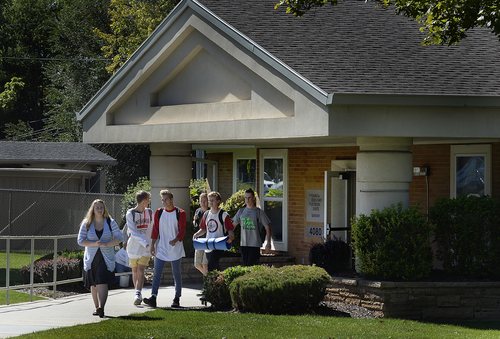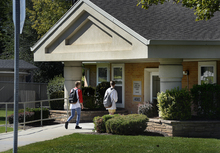This is an archived article that was published on sltrib.com in 2014, and information in the article may be outdated. It is provided only for personal research purposes and may not be reprinted.
Just because Mormon seminary takes place outside traditional high-school buildings doesn't mean its students are free from the trappings of typical classes.
That means showing up for class, reading the assigned texts, even passing tests.
This year, in fact, The Church of Jesus Christ of Latter-day Saints has implemented stricter requirements to graduate from seminary. Now, teens will have to take twice-a-year assessments and fulfill reading requirements as part of their path to graduation.
Students will have to meet the new standards to get certificates of completion at the end of each year and, ultimately, diplomas. Those who don't complete the reading or testing but meet attendance requirements will still receive certificates of recognition each year. The church also tweaked attendance requirements.
"They live in a world so full of healthy obligations as well as an increased level of distraction that our hope is that by the introduction of these additional two elements we could help encourage young people to exercise their agency and choose to reach out and include it more in their lives," said Kelly Haws, associate administrator for seminaries and institutes of religion for the LDS Church.
Students have always been asked to read in and outside class as part of scripture studies in Mormon seminary, said Wayne Davis, manager of communications for seminaries and institutes of religion. But now that reading will be mandatory.
This year, the required reading is the Doctrine and Covenants, part of the LDS canon. Next year, it will be the Old Testament, followed by the New Testament and the faith's signature scripture, the Book of Mormon.
"Our hope," Haws explained, "is that each young person would either have already developed in their lives, or that this would help them develop in their lives, a habit of personal, thoughtful, daily study of the scripture."
As for the tests, they will be given at the end of the first semester or second quarter and then again toward the end of the school year. If students fail, they'll be able to take the tests again, as many times as needed. They can even get help from a book, parent or others.
"We hope it will then give the students more confidence in what they know, and they will then be able to apply and share what they've learned," Davis said. "That's really what we're after, is what they're able to do as a follower of Jesus Christ and as they move ahead and leave seminary.
Though the changes are relatively new, many parents — and even some students — say they're good ones.
Alyssa Hemsley, a 16-year-old junior at Davis High in Kaysville, said tests can be a nuisance, but she understands why they might be needed.
"It's a good thing for the teachers," Hemsley said, "because then they can know where their class is at and what they have to focus on more."
Christian Grow, a 16-year-old junior at Alta High in Sandy, said he likes the changes but understands why some teens might not.
"It's a good way to learn the material," Grow said, "but I know some people probably won't be too happy because seminary in the past has been a class where you could kind of zone out and not focus and do much."
His mother, perhaps not surprisingly, also cheers the new requirements.
"There's been some kids that really take it to heart as far as learning, as far as the different books they're studying that year, and some kind of glide by," Renee Grow said. "It's kind of the same concept as graduating from high school. There are requirements. It's not just show up and graduate, which is how it's been for years."
Bountiful High parent Jerron Hale also praised the stiffer requirements, especially in light of the church lowering the age at which young Mormons may go on full-time missions — to 18 for men and 19 for women.
"It kind of gets them more prepared by being held accountable for the release time they have for seminary," said Hale, a father of five.
Haws said the lower mission ages did not drive the creation of new seminary standards, but "we hope this additional preparation in seminary is going to be a great blessing and help to them as they depart for their missions earlier in their lives."
Though not a big change, the church also has slightly altered seminary attendance rules. Now, instead of requiring 80 percent attendance to graduate, the church is requiring 75 percent attendance (with excused absences) to be consistent with requirements for institutes of religion. Students who attend seminary on release time from school still will be required to make up unexcused absences.
Haws stressed that the new requirements aren't intended to make it tougher for kids to attend seminary.
"We have a very strong interest and desire to have every young person still participate in seminary and we would never want those requirements to stand in the way of them participating," Haws said, "which is a large part of the reason we still award them an award for simply attending class, and we want every young person to come and participate in seminary."
Alta High parent Traci Dolphin appreciates that continued flexibility. She said her son wouldn't likely have graduated from seminary this year had strict attendance requirements been in place.
Dolphin said her son somewhat lost interest in seminary his junior year. But, as a senior, he recommitted and went to seminary early each morning to help make up for the time he missed.
She said such allowances have been key.
"That's what life's about, and we're talking about teenagers," Dolphin said. "Teenagers go through phases."





